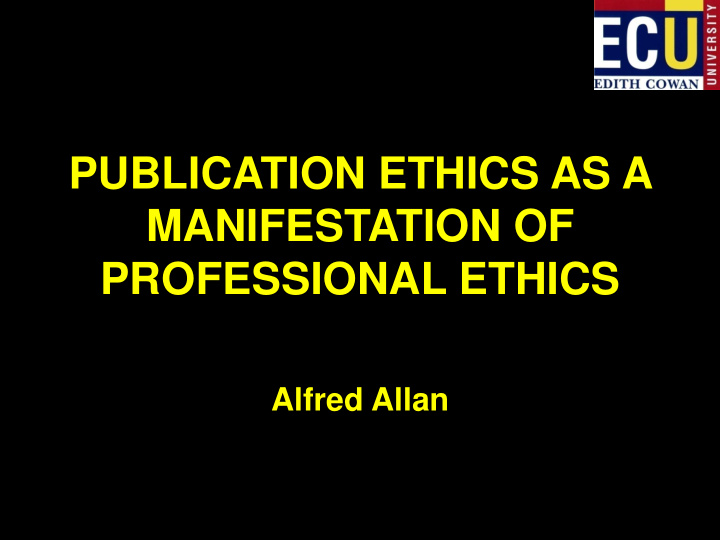



PUBLICATION ETHICS AS A MANIFESTATION OF PROFESSIONAL ETHICS Alfred Allan
AIM Provide a backdrop for other papers Where do they fit in With reference to the underlying principles Only an overview
DISCLAIMER
PUBLICATION ETHICS
Not unique and esoteric
Based on same principles as professional ethics
PROFESSIONAL ETHICS
Stable, though incomplete set of norms widely shared by members of the profession (Beauchamp & Childress)
General agreement, not necessarily consensus Could be implicit Increasingly in writing
But codes only represent part of professional ethics Underlying principles are important
HEALTH & SOCIAL SCIENCES
KANT (1724-1804)
Humans as rational beings Capable of making moral decisions Right and wrong Unique ability Give them an inner worth (dignity) Must respect this dignity of people
Implication is that we must respect all persons irrespective of how we judge them
PRINCIPLES
Eight - arbitrary Nomenclature can differ Not mutually exclusive Prima facie equal weight Can be in conflict Best balance
HUMANITY AUTONOMY JUSTICE RESPONSIBILITY NON-MALEFICENCE FIDELITY BENEFICENCE INTEGRITY 19
RESPONSIBILITY
About accountability to others
All publication role players are accountable to greater society and discipline or profession to advance the knowledge in the field by making knowledge available
But, this may be trumped by one of other principles
AUTONOMY We must respect people’s right to make decisions about things that are of importance to them
Ensure that all participants and role players maKe informed, free and voluntary decisions
Anonymous use of information legitimately obtained by a forensic psychiatrist (Kapoor et al.)
RESPECT FOR HUMANITY
Respect for dignity and rights of people Two elements Dignity Rights (moral and legal)
Rights Prisoner’s life story Intellectual property Plagiarism*
Dignity Respect dignity of people irrespective of how we judge them
Humiliate Defame or insult Pejorative language Insulting and intemperate Debate is good »
Privacy Right to be left alone Confidentiality
» Hematologist writing about a person’s platelets » Forensic psychiatrist writing about mental status of a person who murdered another in a notorious case
Subtle disrespect*
Manner in which we interact with others
Manners Acknowledging others
Punctuality Responding promptly » » Keeping people informed Providing speedy feedback »
INTEGRITY
Simple honesty
Examples mentioned above Plagiarism Fraudulent research
http://www.theworld.org/2011/11/dutch-scientist-diederik-stapel-faked-data /
Preliminary report Several dozens fraudulent papers Science of 2 April 2011 Facing fraud charges
Authors “Is this material worth publishing?” (Walter & Bloch, 2001, p. 33) Conflict of interests: Neville Nature of submission: Richard Authorship
Overlaps with
JUSTICE
Fairness No unjustified discrimination or favouritism
Procedural justice Fairness in decision making
Requires Take into account all relevant information Consider relevant information only Open minded – open to persuasion Unbiased
» Actual and perceived bias Perceptions are important » » What would an independent, reasonable and informed observer think?
Reviewers Blind peer review Does not necessarily remove risk*
Unconscious Theoretical orientation
FIDELITY
Where there is a power imbalance Those with less power (trusters) Must trust that those in power (trustees) will act Competently In their best interests
Trustees must therefore Be trustworthy Act in the best interests of trusters, even if to their own detriment
Editors are in powerful positions
Must therefore not Exploit their position Create a risk of exploitation Create impression there may have been exploitation
A partner’s paper
Must appoint competent reviewers Ensure that they do a competent review*
NONMALEFICENCE
Do no harm Not intentionally or negligently Refrain from engaging in behaviour where there is a reasonably foreseeable risk of harm
How can we harm? Careers Reputations Self-confidence Health
Breuning, S. E., Davis, V. J., Matson, J. L., & Ferguson, D. G. (1982). Effects of thioridazine and withdraw dyskinesias on workshop performance of mentally retarded young adults. American Journal of Psychiatry, 139, 1447-1454.
Often not malicious
Potential of harm when, e.g., Reviewers exceed their competence Editors are overburdened
BENEFICENCE
Do good Anticipate and neutralise factors that may cause harm even when there is no legal obligation Constructive feedback
CONCLUSION Publication ethics Is part and parcel of our publication activities Same principles as those that underlies professional ethics
Every role player has different ethical duties Often requires finding the right balance between conflicting principles
THANK YOU
Recommend
More recommend